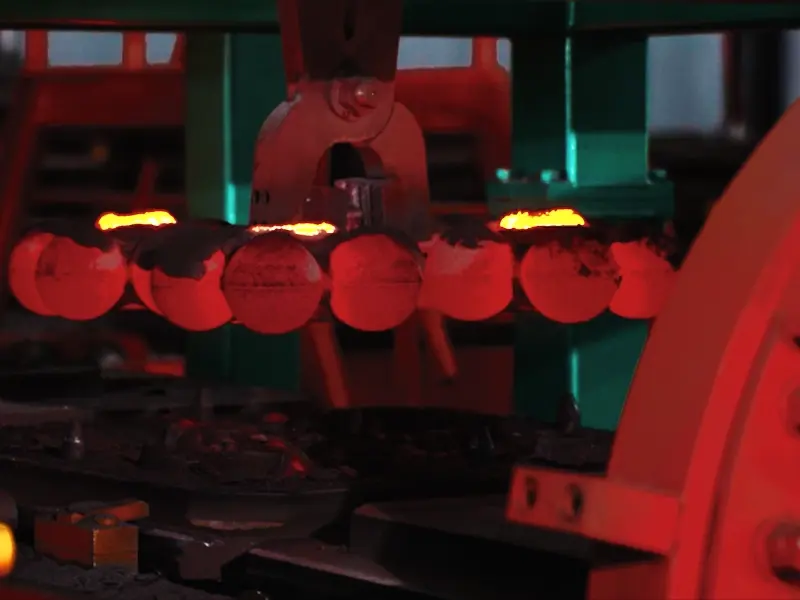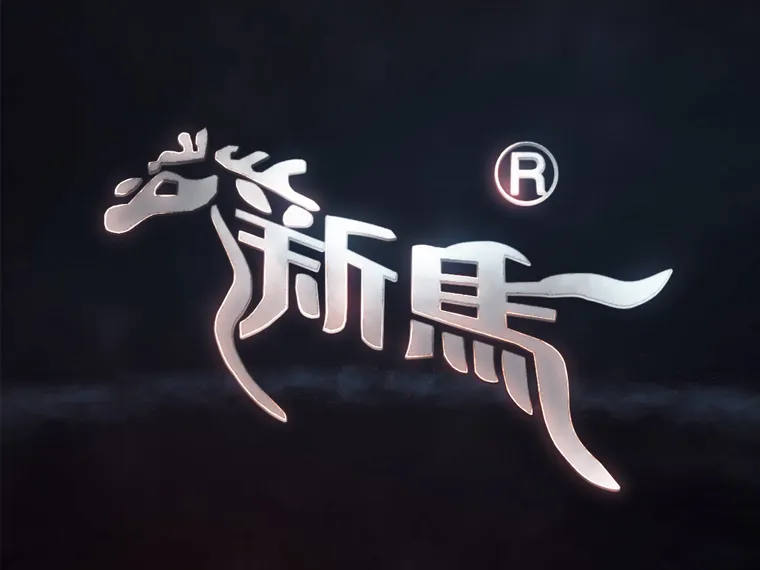The balance between hardness and toughness in high-chromium grinding balls has long been a technological barrier in the industry. Traditional high-chromium grinding balls have a hardness ranging from HRC48 to 58, but industries like mining and cement are increasingly demanding larger ball mills, placing higher requirements on the performance of grinding balls.
Xinma’s high-chromium cast grinding media ball production process includes four main steps: forming (ball manufacturing), separation and cleaning, heat treatment, and inspection. Each process is equipped with corresponding equipment to provide customers with more advanced technology.

Four major technological upgrades lead the industry transformation
Precision Forming: The Foundation of Wear Resistance
Xinma’s high-chromium grinding media ball production begins with precise raw material mixing and efficient melting. In a factory covering more than 10,000 square meters, intermediate frequency induction furnaces melt common scrap steel, ferrochrome, ferromolybdenum, and other materials into precisely composed molten iron.
Real-time monitoring ensures the chemical composition of the molten iron is strictly controlled within the optimal range: 2.0-3.0% carbon, 17-21% chromium, 0.4-0.8% boron, and trace elements like copper and nickel to enhance overall performance. When the temperature of the molten iron drops to the critical range of 1530-1560°C, a modifier is added for metamorphic treatment.
The temperature-controlled automatic casting system is the key to ensuring uniform internal structure in the grinding balls. Xinma’s closed casting system ensures that the molten iron solidifies in a stable state, avoiding the air holes and segregation defects common in traditional casting. This breakthrough in the process refines the grain size of the cast state of the grinding balls and significantly improves the density of the structure.
After forming, the grinding balls are sent to an automatic temperature-controlled cooling area, preparing them for the next process. The precisely controlled cooling curve effectively prevents internal stress cracks, laying a good foundation for subsequent heat treatment.
Intelligent Separation: Efficient Cleaning
After the grinding balls are removed from the mold, they enter the crucial separation and cleaning process. In Xinma’s casting workshop, automatic shot blasting equipment handles hundreds of newly molded grinding balls per minute. High-speed steel shots are sprayed at the ball surface to thoroughly remove attached sand particles and oxide layers.
Traditional manual cleaning is inefficient and inconsistent, whereas our automation system guarantees the consistency of each batch. The cleaned balls achieve a surface roughness of Ra3.2 or higher, providing ideal surface conditions for subsequent heat treatment.
The new production line is equipped with a visual recognition robotic arm sorting system that automatically identifies and removes defective products. The system uses high-resolution cameras to capture images of the ball surfaces and AI algorithms to determine if there are any defects, such as cracks or shrinkage holes, with a sorting accuracy rate of 99.2%.
At the end of the cleaning process, the grinding balls are neatly arranged on the conveyor belt, ready for the heat treatment section. The entire separation and cleaning process is conducted in a closed environment, reducing dust emissions by 80% compared to traditional processes and meeting national environmental protection standards.
Heat Treatment Revolution: Balancing Hardness and Toughness
The heat treatment stage is a key breakthrough in Xinma’s technology. The newly developed oil-quenched liquid formula plays a critical role: a water-based solution composed of polyvinylpyrrolidone, carboxymethyl cellulose sodium, and phytic acid, which combines the slow cooling properties of oil quenching and the high cooling efficiency of water quenching.
Traditional oil quenching causes high pollution and limited hardness improvement, while water quenching is prone to cracking. Our solution perfectly balances environmental protection and performance requirements. This quenching liquid ensures the intensity of quenching while effectively reducing heat treatment stress on the grinding balls.
The quenching process employs an innovative six-stage temperature zone control: starting at 380°C, stepping up to 530°C, 680°C, 780°C, and 880°C, and finally achieving austenitization at 980°C. Each temperature zone is maintained for 1-1.5 hours, allowing the alloy elements to diffuse fully.
After quenching, the cast grinding balls undergo low-temperature tempering for 4-10 hours in the range of 210-300°C. This process converts residual austenite into tempered martensite, significantly improving toughness while maintaining high hardness. The aging treatment further relieves internal stress, ensuring that the grinding balls remain stable under impact conditions.
大景_WH_800x600px-1.webp)
Precision Inspection: Ensuring Excellent Quality
After heat treatment, the grinding balls enter a full-process inspection phase. In Xinma’s testing center, a direct-reading spectrometer analyzes the chemical composition of the balls in milliseconds to ensure the alloy components are accurately within standards. The Rockwell hardness testing system also works in tandem, generating real-time hardness distribution maps.
The most notable feature is the ball-drop test area, where a 10-meter drop impact test simulates the harshest working conditions. Each batch of grinding balls must withstand an impact energy of over 4J/cm² without breaking, with the breakage rate strictly controlled to within 0.2%.
Xinma’s testing laboratory is also equipped with an automatic metallographic analysis system that observes the internal structure of the grinding balls at a nanometer level. Data shows that 80% of the grain size of the grinding balls treated with the new process is less than 40 nanometers, with a 60% improvement in the uniformity of carbide distribution. This microscopic structure is the fundamental guarantee of high-wear-resistance grinding balls.
Each batch of products has a complete digital record, enabling full lifecycle quality traceability. Test data is uploaded in real-time to the MES system, triggering immediate adjustments to process parameters in case of abnormalities, forming a closed-loop optimization mechanism for manufacturing.
Xinma’s innovative casting process has resulted in a breakthrough in product performance. Tests show that the new high-chromium grinding balls have a stable hardness range of HRC63-65, with an impact toughness (ak value) of ≥4J/cm², far exceeding the industry average. In continuous operation tests at cement plants, wear is reduced to 35 grams per ton of cement, and service life is extended by 2.3 times. Environmental benefits are also significant, as polyethylene oxide and polyoxymethylene copolymer (PAG) water-soluble quenching media completely replace traditional quenching oils, eliminating oil smoke pollution. The heat treatment energy consumption is reduced by 40%, cutting CO2 emissions by about 2,800 tons annually.
The four-step technological innovation is not just an equipment upgrade but also a revolution in manufacturing philosophy. Xinma’s breakthroughs in casting technology are driving the industrial cluster upgrade. As the global high-chromium grinding ball market surpasses 20 billion yuan by 2025, Chinese manufacturing is no longer synonymous with low prices but has become a new benchmark for wear resistance performance and technological innovation.

